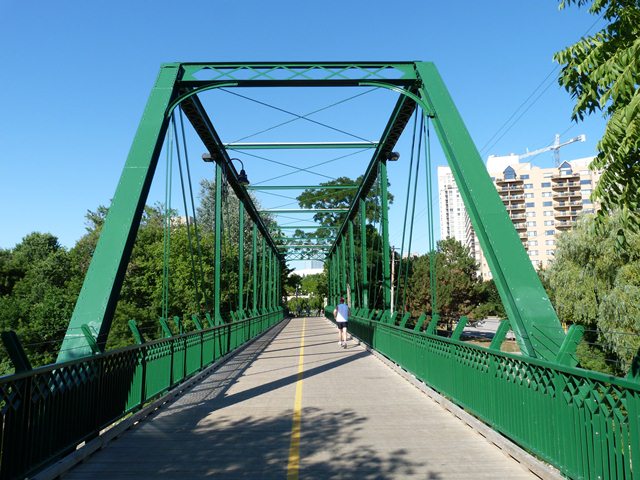We Recommend:
Bach Steel - Experts at historic truss bridge restoration.
BridgeHunter.com Phase 1 is released to the public! - Visit Now
King Street Bridge

Primary Photographer(s): Nathan Holth and Rick McOmber
Bridge Documented: July 12, 2005 and July 20, 2012
London: Middlesex County, Ontario: Canada
Metal 9 Panel Pin-Connected Pratt Through Truss, Fixed and Approach Spans: Metal Stringer (Multi-Beam), Fixed
1897 By Builder/Contractor: Central Bridge and Engineering Company of Peterborough, Ontario
2010
Not Available
213.0 Feet (64.9 Meters)
Not Available
1 Main Span(s)
Not Applicable

View Information About HSR Ratings
Bridge Documentation
There are very few remaining pin connected truss bridges in Ontario. London is lucky enough to have several, and this King Street Bridge is one.
When viewed from afar, this appears to be a classic Pratt pin connected through truss with nine panels. In terms of the truss, this is correct. However, a closer inspection reveals that this bridge is unusual, in that it carries a large storm sewer pipe under its deck. The bridge's floorbeams have a special variable depth and trussed design that allows the pipe to pass through the floorbeams. Many bridges carry small pipes. Based on the fact that the floorbeams are not original and show a welded design, one might think that this pipe is recent addition to the bridge. However, looking at the west abutment, inscribed into the concrete is "London Sewerage System A.D. 1897" which demonstrates that this bridge always carried a sewer pipe of some sort, and that this was one of the main reasons the bridge was built. The bridge did also carry vehicular traffic originally as well. According to a Municipal Year Book found by researcher Len Fluhrer, this bridge was closed to vehicular traffic in 1947. Sometime after 1947 and prior to the 2010 rehabilitation, the deck was reconfigured for pedestrian use. The middle section of the pedestrian deck was left open, which provided a view of the pipe line. It is not known if this gap was intended to reduce cost, reduce loads on the bridge, are provide a view of the pipe. In 2010, this bridge was rehabilitated, including sandblasting and painting and replacement of the deck. The non-original railings were also replaced with a different, more ornate, style of modern railing. The new deck removed the gap in the middle.
This bridge remains in its original location, although King Street no longer makes it to this bridge. A park on the east side of this bridge is where the road once was. On the other side, the road still mostly leads up to the bridge, but instead goes into a parking lot. The bridge remains in use for pedestrian use, and appeared to be in excellent condition. The bridge is heavily used by pedestrians and bicyclists.
This bridge is a highly significant bridge in Ontario, as both pre-1900 bridges and pin-connected truss bridges are very rare in the province. The 2010 preservation project demonstrates that this bridge has a stronger preservation commitment, which is very good to see.
This bridge is tagged with the following special condition(s): Reused
![]()
Photo Galleries and Videos: King Street Bridge
2012 Bridge Photo-Documentation
Original / Full Size PhotosA collection of overview and detail photos, taken July 20, 2012, after rehabilitation. This gallery offers photos in the highest available resolution and file size in a touch-friendly popup viewer.
Alternatively, Browse Without Using Viewer
![]()
2012 Bridge Photo-Documentation
Mobile Optimized PhotosA collection of overview and detail photos, taken July 20, 2012, after rehabilitation. This gallery features data-friendly, fast-loading photos in a touch-friendly popup viewer.
Alternatively, Browse Without Using Viewer
![]()
2005 Bridge Photo-Documentation
Original / Full Size PhotosA collection of overview and detail photos, taken July 12, 2005, before rehabilitation. This gallery offers photos in the highest available resolution and file size in a touch-friendly popup viewer.
Alternatively, Browse Without Using Viewer
![]()
2005 Bridge Photo-Documentation
Mobile Optimized PhotosA collection of overview and detail photos, taken July 12, 2005 before rehabilitation. This gallery features data-friendly, fast-loading photos in a touch-friendly popup viewer.
Alternatively, Browse Without Using Viewer
![]()
Maps and Links: King Street Bridge
Coordinates (Latitude, Longitude):
Search For Additional Bridge Listings:
Additional Maps:
Google Streetview (If Available)
GeoHack (Additional Links and Coordinates)
Apple Maps (Via DuckDuckGo Search)
Apple Maps (Apple devices only)
Android: Open Location In Your Map or GPS App
Flickr Gallery (Find Nearby Photos)
Wikimedia Commons (Find Nearby Photos)
Directions Via Sygic For Android
Directions Via Sygic For iOS and Android Dolphin Browser



